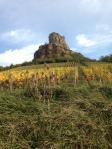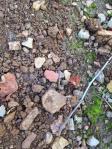Welcome to Terroirist Tuesday. Today’s Topic: The Mâconnais, Part 2.
By: L.M. Archer, FWS



Greetings, geniuses! So much for trick questions – you met me at every turn along Route Mâconnais. Well played!
Answers to last week’s quiz on Burgundy’s Mâconnais wine region as follows:
1. Chardonnay is: All of the above. The name of a town in Mâcon, the name of the white grape varietal used to make Mâcon wine, and (according to folklore) the name given to ‘the grapes that grown near the birds’ flitting about Mâcon’s abundant thistles.
2. The Soils of the Mâconnais most resemble those of: Côte d’Or.
This means bedrock of Jurassic origin, with layers of middle and upper Jurassic soils. Translation: Lots of delicious, complex limestone layers, translating into the trademark, flinty flavors of Pouilly-Fuissé, crisp, quaffable Viré-Clessé and smooth, slightly more complex Saint-Véran.
Unlike the Cote d’Or, the fault blocks of the Mâconnais tilt east, not west.The Mâconnais’ gentle chain of hills also contain pockets of clay, where crops and livestock live. The hills increase in altitude moving south, culminating in the Roche de Solutré and Vergisson.
3. The Maconnais has how many Grand Crus? None.
Well done, dear readers! You nailed this. Mâconnais has neither Grand Crus nor Premier Crus, though the winemakers of Pouilly-Fuissé hope to change that – some in the region have applied for Premier Cru status, so stay tuned.
The Mâconnais contain Village and Regional appellations.
Approved Mâconnais Village appellations, all 100% chardonnay wines, include:
1. Pouilly-Fuissé (Actually three (3) sections: Pouilly-Fuissé, Pouilly-Loché, and Pouilly-Vinzelles)
2. Saint-Véran (Actually two geographic ‘islands’ divided north and south by Pouilly-Fuisse.)
3. Viré-Clessé (Northern-most appellation, near the town of Mâcon.)
Approved Regional Mâconnais appelations include both red and white wines.
Regional Mâconnais White Wine Appelations, 100% Chardonnay, include:
1. Mâcon
2. Mâcon-Villages
3. Mâcon + Geographic Designation (e.g., Mâcon-Prissé, Mâcon-Lugny.)
Regional Maconnais Red Wine Appellations include:
1. Mâcon (Mostly Gamay.)
2. Mâcon + Geographic Designation (Mostly Gamay.)
3. Bourgogne (Mostly Pinot Noir or Gamay-Pinot Noir cuvée Bourgogne Pas Tout Grains.)
Not a lot of red wine going on in the Mâconnais – keep in mind that white wine accounts for 89% of its wine production!
4. In the Mâconnais, the Rock of Solutré: Is a limestone escarpement located in Pouilly-Fuissé.
While archeologists have discovered thousands of ancient horse bones at the base of the Rock of Solutré, a bioherm by definition contains organic marine fossils. (A note on the dead horses: The old theory held that thousands of years ago the locals drove herds of wild horses off the cliffs for meat. The most recent theory summises that the horse remains mark the location of an ancient Roman camp.)
The Maconnais series continues next week, when binNotes shares recent domaine visit tasting notes and observations from Burgundy’s ‘other white wine‘ region. Cheers!
Next week’s Terroirist Tuesday topic: Mâconnais, Part 3: Meet the Winemakers.
Copyrighted 2013. Images courtesy of author. All Rights Reserved.
Follow binNotes: | Facebook | Twitter | Pinterest
Filed under: Chardonnay, France, French Wine, French Wineries, Maconnais, Wine Tasting Tagged: Burgundy, Chardonnay, maconnais, terroir, wine

